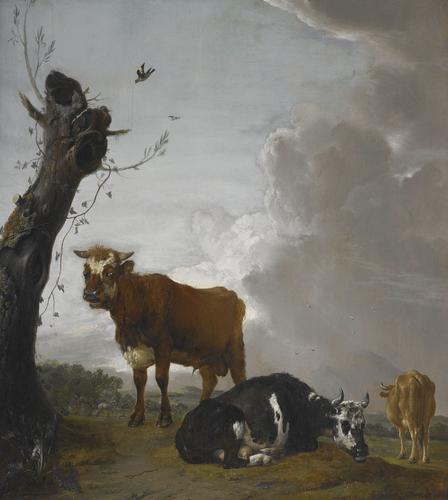-
1 of 253523 objects
A Young Bull and two Cows in a Meadow Signed and dated 1649
Oil on panel | 70.7 x 63.0 cm (support, canvas/panel/stretcher external) | RCIN 404585
-
Paulus Potter (1625-54) was born in Enkhuizen and studied with his father Pieter Symonsz. Potter; his brief career was divided between three major Dutch artistic centres, Delft 1646–9, The Hague 1649–52 and Amsterdam 1652–4. His life-sized Young Bull (Mauritshuis, The Hague), painted in 1647, when he was only 22, announced two distinctive attributes of his art, which can also be seen in this smaller bull of two years later. The first was described by Fromentin: ‘Paul Potter’s extraordinarily exact eye, whose penetrating energy nothing could tire, took in every detail, scrutinized, expressed all too carefully, never became confused, but never ceased work.’ This ‘fixation’ of the eye is offset by the second effect – the creation of luminous skies and a sweep of landscape conveyed within a tiny wedge of background. These characteristics mark a decisive departure from the technique of the tonal school: with strong contrasts of colour and tone rather than subtle transitions; with a thicker, drier and more opaque paint layer built up crisply to suggest the varied textures of bark, grass and the coats of animals.
Though a reduced version of the one in the Mauritshuis, this bull confronts us with an equal intensity; he is seen from below, his dark form silhouetted against a blaze of light as a storm clears. This animal was painted in an age when resemblance between man and beast was thought to provide serious scientific evidence as to the natures of both. A man’s character could then be read by reference to the animal he most resembled: the bovine physiognomy, for example, is illustrated with a comparison of a bull-headed man and an actual bull in Giovanni Battista della Porta’s De humana physiognomonia of 1586. The same thing worked the other way round: animal behaviour and expression was generally read anthropomorphically. This bull looks very human: the bulging eyes, open mouth and apparent frown suggest that he is telling us to be on our guard. These two Young Bulls (this and the one in the Mauritshuis) were painted at the time (1648) that the United Provinces finally won their independence from Spain, after an 80-year struggle. One personification of these United Provinces was ‘the Hollandse kuh, the Dutch cow: fat, fecund and peaceable (and symbolizing both rural and commercial prosperity)’, which Simon Schama goes on to describe as ‘a form of visual self-congratulation’. A famous satire from the early days of the war shows Philip II of Spain trying to ride the Netherlandish Cow, while Queen Elizabeth of England feeds it; William the Silent leads it; the Duke of Anjou is fouled by it; while an unidentified figure in Spanish costume milks it. A series of five allegorical prints by Hendrick Hondius was published in 1644 warning the Dutch not to be defrauded by the Spanish in the negotiations leading up to the conclusion of the war; one of them, Cows by a River, is inscribed ‘Watchmen do your best to see that the Dutch cow is not stolen from us.’ Potter’s animals are not these fat docile cows, but lean and pugnacious bulls; they would still surely have been read allegorically by his original audience. This is the ‘Dutch Bull’ defending his family and his meadow from all-comers.
Signed and dated: 'Paulus Potter: f: 1649'Provenance
Purchased by George IV from Sir Thomas Baring as part of a group of 86 Dutch and Flemish paintings, most of which were collected by Sir Thomas’s father, Sir Francis Baring; they arrived at Carlton House on 6 May 1814; recorded in the anti-room to the Dining Room at Carlton House in 1819 (no 87); in the Picture Gallery at Buckingham Palace in 1841 (no 128)
-
Medium and techniques
Oil on panel
Measurements
70.7 x 63.0 cm (support, canvas/panel/stretcher external)
93.4 x 86.1 x 6.5 cm (frame, external)
Category
Object type(s)
Other number(s)
